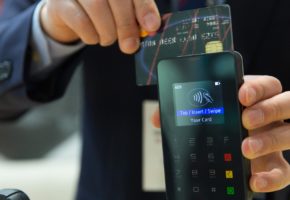Payment cards, like credit and debit cards, are so ubiquitous it seems nearly impossible to think of a time when we didn’t use them. In the grand scheme of things, however, they’re a pretty recent invention. The story of the first credit card begins with a restaurant bill and a forgotten wallet. The story goes like this: a businessman took some clients out to dinner in 1949, forgot his wallet, and the Diners Club Card was born.
While this wasn’t the first payment card issued by a financial institution, it was definitely the beginning of what we now know as the credit card. As credit cards began to be used more and more, there needed to be a way to properly charge and track them. Out of this necessity, the credit card processing machine was born.
First Machines
The first machines weren’t even machines—at least, not in the way we think of them now. You may remember them, the manual imprinters that made the loud noise when used. Clerks filled out a form, placed the form in the machine, place the card under the form, and ran the imprinter mechanism over the form and card to “imprint” the numbers and name on the form. This form would be signed by the customer and mailed to the bank to receive payment. Some businesses still keep a manual imprinter credit card processing machine on hand in case of communications interruption.
Phone Authorization
The next evolutionary step in credit card machines was the phone authorisation. Merchants could call a phone number listed on the card, give the credit card number to the representative, and wait for authorisation by verbal confirmation. As you can imagine, this was a lengthy transaction due to wait times, busy signals, and other limitations. As such, this process was typically reserved for larger transactions.
POS
The point of sale terminal was introduced by Visa in 1979. This was also the year that MasterCard introduced the magnetic stripe that’s still found on the back of credit cards today. Over the years this technology became better and better, and to a certain degree it’s still the most prevalent credit card processing machine used. The countertop unit found in most brick and mortar stores is based on the point of sale concept.
The Present and Future
We’re now entering a period where credit card processing is changing in dramatic fashion. Mobile swiping devices that attach to smart devices like phones and tablets are creating a more flexible way to accept credit cards. What’s more is that credit cards themselves are changing. Smartphones allow consumers to enter their information into an app or native software program and use their phone as their payment device.
Credit cards are now featuring chips that are read by readers as opposed to magnetic strips that are read by swipe readers. Credit card processing machines are able to read chips, process contactless cards and smart devices, and read magnetic stripes, and they’ll continue to improve how they process credit card transactions.
Ultimately, credit card terminals and credit cards will improve as consumers needs and demands change. At Allied Wallet, we’re dedicated to being on the cutting edge of this technological push. Call us today to learn more about the changing ways merchants can accept and process credit card payments.






